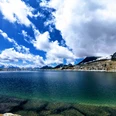- Photos & Map
How would you like to arrive?
- Description
- Good to know
- Nearby
Research and Findings
In 1852 he was admitted to the Royal Academy on the strength of his research in magnetism and the polarisation of light. In 1853, Tyndall was appointed professor of physics and natural philosophy at the Royal Institution in London. He also continued to be involved in research and was concerned with electromagnetism, thermodynamics, bacteriology and glacial movements. The Irish researcher was awarded honorary doctorates by several universities, and numerous scientific societies accepted him as an honorary member.
Stays in Switzerland and on the Belalp
After a first trip to Switzerland in 1849, Tyndall spent summers in the Alps between 1857 and 1869. In 1861, together with Johann Joseph Benet and Ulrich Wenger, he succeeded in making the first ascent of the Weisshorn. In 1862 he narrowly failed to make the first ascent of the Matterhorn.
Between 1877 and 1893 Tyndall spent the summer months with his wife Louisa Charlotte in the Alp Lusgen villa he had built on the Belalp. In 1887, he was awarded honorary citizenship by the municipality of Naters. At the same time as his appointment as honorary burgomaster of Naters, John Tyndall retired. He died on 4 December 1893 in Hindhead, a small village between London and the south-west coast of England.
Good to know
Payment methods
License (master data)
Blatten-Belalp Tourismus AG
Nearby






